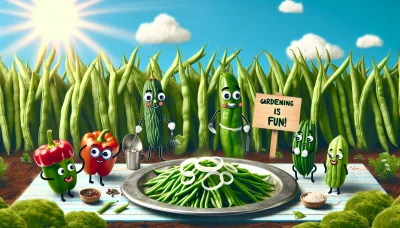Can you eat persimmon skin Quiz
Test Your Knowledge
Question of
Can You Eat Persimmon Skin?
Persimmons are a popular fruit among gardening enthusiasts, known for their sweet, honey-like flavor and bright, orange color. Originating from Asia, these fruits have gained popularity worldwide and are a staple in many gardens. A common question that arises among persimmon lovers is whether the skin of the fruit is edible or if it should be peeled before consumption.
What Are Persimmons?
Persimmons are vibrant, sweet fruits that are commonly grown in gardens around the world. There are two main types of persimmons: astringent and non-astringent. Astringent persimmons, such as the Hachiya variety, are known for their tartness when unripe and must be fully soft before they can be enjoyed. On the other hand, non-astringent persimmons like the Fuyu variety can be eaten while still firm, offering a crisp, sweet flavor without the tartness. These differences make each variety unique, catering to various culinary uses and personal preferences.
Nutritional Benefits of Persimmon Skin
Persimmon skin is rich in dietary fiber, antioxidants, and essential nutrients, making it an excellent addition to a healthy diet. The skin of the persimmon contains a high concentration of phytonutrients, including beta-carotene, lycopene, and lutein, which are known for their powerful antioxidant properties. These compounds help in neutralizing harmful free radicals in the body, reducing the risk of chronic diseases such as heart disease and cancer. The dietary fiber present in the skin aids in digestion and helps in maintaining a healthy gut flora, promoting regular bowel movements and preventing constipation. Additionally, the skin is a good source of vitamin C, which supports the immune system, and potassium, which is essential for heart health and maintaining normal blood pressure levels. Including persimmon skin in your diet can contribute to overall health and well-being, making it a valuable component of a balanced diet.
How to Properly Prepare Persimmons
- Select ripe persimmons: Choose persimmons that are soft to the touch and have a deep orange color. Unripe persimmons can be very astringent.
- Wash the persimmons: Rinse the persimmons under cool running water to remove any dirt or debris. Gently dry them with a clean towel.
- Remove the leaves: If there are any leaves attached to the stem, gently pluck them off or cut them out with a knife.
- Cut off the top: Use a sharp knife to slice off the top of the persimmon, where the stem is, to make it easier to eat.
- Check the skin: Decide whether to eat the skin or not. For some, the skin of a ripe persimmon can be pleasantly edible, while others may find it too tough. If you choose to eat the skin, ensure it's thoroughly washed.
- Slice or eat whole: You can either slice the persimmon into wedges, like you would a tomato, or eat it whole. If you've decided to remove the skin, you can peel it with a knife or vegetable peeler before slicing.
- Enjoy: Persimmons can be eaten fresh, added to salads, or used in baking. Enjoy the sweet, honey-like flavor of this unique fruit!
Tip: If you're trying the skin for the first time, start with a small piece to ensure its texture and taste are to your liking.
Gardening Tips for Growing Persimmons
To grow persimmons successfully in your home garden, start by ensuring your soil is well-draining and rich in organic matter. Persimmons thrive in soil with a neutral to slightly acidic pH. Full sunlight is crucial for the health and fruit production of your persimmon tree, so choose a planting location that receives at least 6 hours of direct sunlight daily. Watering needs vary throughout the growing season; young trees require consistent moisture, especially during dry spells. However, once established, persimmons are quite drought-tolerant. Regular deep watering encourages deep root growth, but be careful not to overwater, as this can lead to root rot.
Common Concerns About Eating Persimmon Skin
Many people have concerns about eating the skin of persimmons, with the most common issues revolving around texture and pesticide residue. Some believe that the skin may be too tough or bitter, affecting the overall taste and experience of eating this fruit. However, the texture of the skin can vary depending on the type of persimmon and its ripeness. For example, the Fuyu persimmon, when fully ripe, has a skin that is quite thin and edible, offering a pleasant contrast to the sweet, soft flesh inside.
Another concern is the presence of pesticide residues on the skin. Like with many fruits, persimmons are often exposed to pesticides during cultivation. To mitigate this risk, it is recommended to thoroughly wash the fruit under running water before consumption. For those who are still apprehensive, buying organic persimmons can be a good alternative, as they are grown without synthetic pesticides or fertilizers. Ultimately, whether to eat the skin or not is a matter of personal preference, but knowing these facts can help in making an informed decision.
Conclusion: Enjoying Persimmons to the Fullest
In summary, persimmons offer a unique taste and nutritional profile that can enhance your diet in many ways. Through proper preparation, including washing and potentially peeling for those who prefer a less astringent experience, persimmons can be enjoyed to their fullest. However, we encourage readers to try eating the skin of the persimmon as well, as it contains additional nutrients and fiber that contribute to a healthy lifestyle. Integrating persimmons into your diet not only adds variety but also supports a garden-centric approach to eating, emphasizing the value of fresh, home-grown produce. Whether you're a long-time fan or a curious newcomer, there's never been a better time to explore the delightful flavors and benefits of persimmons.












